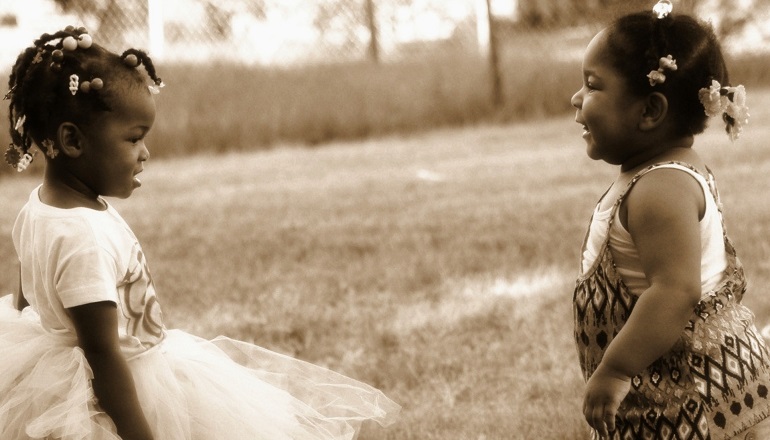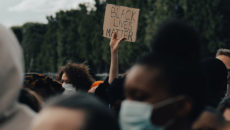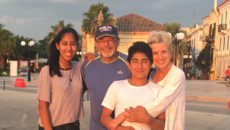Not Mine Alone
When strangers see me with my biracial, two-year-old daughter, they feel compelled to ask me if she’s mine. I always say, “Yes!” I know it when she lays a slobbery kiss on my lips, or when she throws herself on the floor, screaming, because I won’t let her play in the refrigerator. She couldn’t be more “mine.”
And yet, she is not mine alone. All parents eventually learn that their children do not belong only to them. But it is rarely obvious at such an early age.
In addition to her birth family and our extended family, Elizabeth is claimed by others. African-American women we do not know approach us comfortably, eliciting a special smile with their melodic murmur of, “Hey, pretty girl.” When my husband shows her off at his office, black women with whom he works offer tough counsel, criticizing her hair and suggesting products. My heart sinks a bit when he comes home from one of these visits, though I’m trying hard to help Elizabeth fit into a culture that I’m still learning about. On the other hand, she is already important to these strangers and acquaintances, which is fascinating and wonderful.
To pretend that Elizabeth is mine alone isn’t possible, given the colors of our skin. But more than that, it isn’t true. Our family doesn’t belong only to us, either. We are the white people who adopted black children, and now people of all races look at us twice. We are a public family more than ever before. There is only one future for us, and it lies in tolerance and integration. And as much as I hope Elizabeth and her brother will feel comfortable around and welcome among people of all races as they grow, I hope the same for my biological children, my husband, and myself. —Jennifer Girod, Indianapolis, Indiana
Our Diversity Opens Doors
Instead of experiencing negativity because we are a multiracial family, our reality is quite the opposite. In fact, I have noticed that we are more warmly received in public when accompanied by all four of our children than when we are out with our one Caucasian child. The number of doors opened, literally and figuratively, is increased by the diversity of our family. All of our lives have been greatly enriched by the many friends and opportunities that come to us because we are a multiracial family. —Angela, via e-mail
A Priceless Reply
We adopted three children (our eldest is Mongolian, and we recently adopted African-American siblings), and we have three biological children. One question that we’re asked very often—”Why did you adopt from a different race?”—never ceases to amaze me. At a restaurant, soon after his adoption was finalized, our son wanted to know why the people at the next table kept staring at us. I replied, “Those people think you and your sister are the most beautiful kids they have ever seen.” The smile on his face was priceless. —Sue, via e-mail
The Many Shades of Multiracial Identity
An essay by Gish Jenillustrates one type of encounter biracial children might face, but her assumptions require further scrutiny. Jen writes, “Chinese, for example, trumps Irish and black trumps white… always and forever.” Not so fast. The literature on biracial identity development is filled with examples that contradict this. Ask any number of black-white biracials who have been perceived as Latino, Indian, or white. Or Asian-white biracials who are asked repeatedly, “What are you?” There are many shades of the multiracial experience. Assuming that half-white biracial people will always be seen as a member of their minority half, ignores a large part of multiracial identity. —Elliott Lewis, via e-mail
Playful Support
Along with our referral, our social worker gave me the name of a local woman who had adopted from the same agency. We had a great conversation and decided to get together with our kids. Thus, our Support & Play Group was born. We meet every month at a park, play facility, or zoo. Most of the parents are Caucasian and all of the children are African-American or biracial. We enjoy the chance to socialize, talk about adoption, and, above all, play. —Michele Johnson- Bergmeier, Wamego, Kansas
Transracial Parenting, One Stage at a Time
I have begun to identify the stages I’ve gone through in parenting a child of color. For the first two years, I was busy making my daughter my own, operating from a fairly color-blind position. Next came the multi-cultural stage—attending Guatemalan festivals, cooking Guatemalan food, and befriending other parents who had adopted from Guatemala. As my daughter started into elementary school and began to confront race and racism on her own, we entered the making an anti-racist family stage. Now, I am working on bringing adults of color into my family circle. How can our children not feel less than if our only adult friends are white? These stages are not, of course, as clear-cut as I make them sound, but knowing there is a structure can keep us on the path. —Deborah, via e-mail



